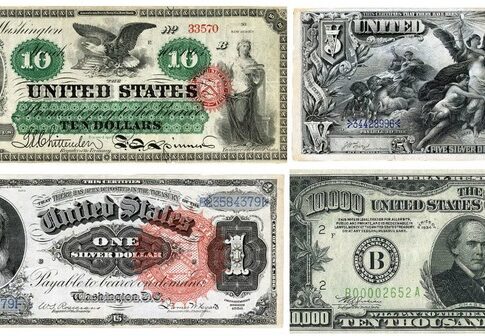The 19th century was a period of vast and sometimes confusing change for American currency. Unlike the standardized dollars and cents we use today, money during this era was a messy, often distrusted, collection of coinage and countless varieties of paper notes. The century’s history of money is the story of the U.S. federal government slowly and painfully wresting control from local banks and foreign powers to create a truly national economic identity.
Part 1: The Enduring Importance of Coinage
Despite the proliferation of paper, coins—backed by gold and silver—were the trusted bedrock of the 19th-century economy. The Coinage Act of 1792 established the U.S. Mint and the dollar as the standard unit, but it took decades for U.S. coins to fully dominate circulation.
The Look of Coins: Early coins were designed to convey the ideals of the new republic.
- Obverse (Heads): Typically featured personifications of Liberty, often depicted as a classical goddess with flowing hair or a cap.
- Reverse (Tails): Almost universally featured the Eagle, a symbol of national strength and freedom.
As the century progressed, the designs evolved. New denominations and metal scarcity drove change, especially after the California Gold Rush of 1849, which flooded the market with gold and necessitated smaller gold coins. The later part of the century saw the introduction of more iconic American imagery, such as the famous Indian Head Penny and the Morgan Silver Dollar, the latter of which became a symbol of the debates over silver coinage.
Part 2: The Chaos of Paper Money (Pre-Civil War)
Before the Civil War, there was no standard federal paper currency. If you were paid in paper, it was almost certainly a banknote issued by one of the hundreds, and eventually thousands, of state-chartered or private banks.
The currency landscape was incredibly fragmented:
- Foreign Coins: The Spanish silver dollar, or piece of eight, was so trusted and widely available that it remained legal tender until Congress officially banned all foreign coins in 1857.
- Wildcat Banknotes: These notes were a source of constant confusion and risk. Since each bank issued its own design, there was no uniformity. The value of a note depended entirely on the financial stability of the bank that issued it. Banks in remote areas were often nicknamed “wildcat banks” because they were hard to reach to redeem the notes for metal.
Because of this instability, a common sight was the “banknote reporter,” a weekly publication that listed banks that had failed or notes that were counterfeit, allowing merchants to know which notes to accept and at what discount.
Part 3: Standardization Through Crisis (The Civil War Era)
The sheer financial demands of the Civil War forced the federal government to break tradition and assert control over the money supply. This necessity gave birth to the national paper currency system.
- Demand Notes (1861): The first federally issued paper money, these notes earned the nickname “greenbacks” because of the green ink used on the reverse side to deter counterfeiting. They were, in theory, payable “on demand” in specie (gold or silver) at certain Treasury offices.
- United States Notes (“Greenbacks”): As the war intensified, the U.S. government issued paper money that was no longer backed by gold but by the government’s promise to pay. This move established a crucial precedent: the government could issue fiat currency.
In 1863, the National Banking Act standardized this system. It created a network of federally chartered banks that were required to issue uniform National Bank Notes. The law effectively taxed the old state banknotes out of existence, finally creating a uniform national currency recognized everywhere.
Part 4: The Great Silver Debate
The latter half of the century was dominated by the struggle between gold and silver standards—a battle known as the bimetallism debate.
- The Gold Standard: Favored by creditors, bankers, and industry leaders in the Northeast, the gold standard created a deflationary environment that kept prices stable but made it harder for debtors (like farmers) to repay loans.
- The Free Silver Movement: Supported by agrarian and Western interests (where silver was mined), this movement sought to introduce silver into coinage without limit. They believed this would inflate the money supply, raise crop prices, and make debt easier to manage.
This political battle led to acts like the Bland–Allison Act of 1878, which required the Treasury to purchase and coin a specific amount of silver each month. The conflict finally resolved at the close of the century when the Gold Standard Act of 1900 formally put the U.S. entirely on the gold standard, solidifying the monetary system that would last until the Great Depression.
The 19th century transformed U.S. money from a hodgepodge of local promissory notes and foreign silver into a strong, centralized, and standardized national currency, paving the way for the economic powerhouse America would become.


